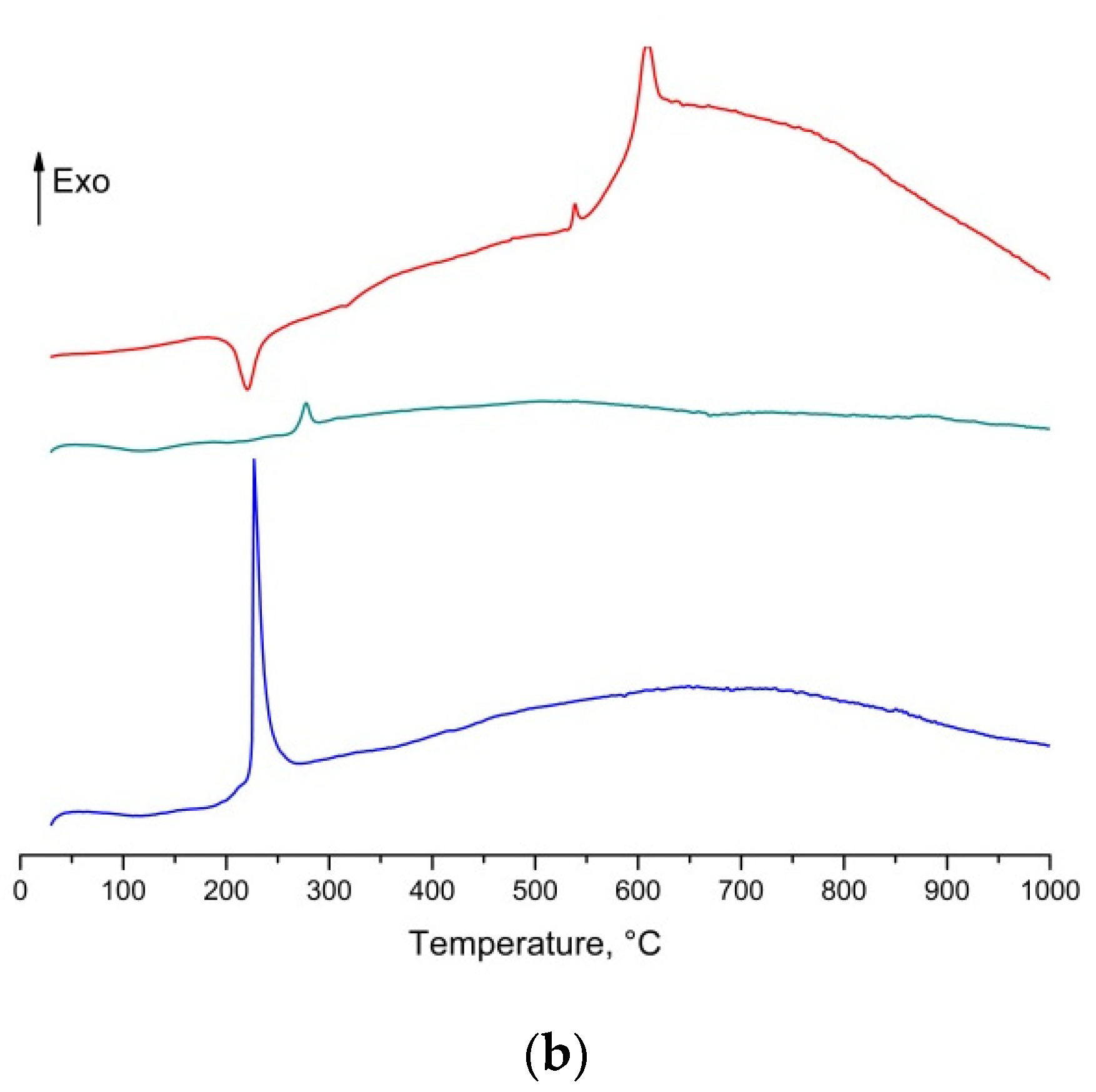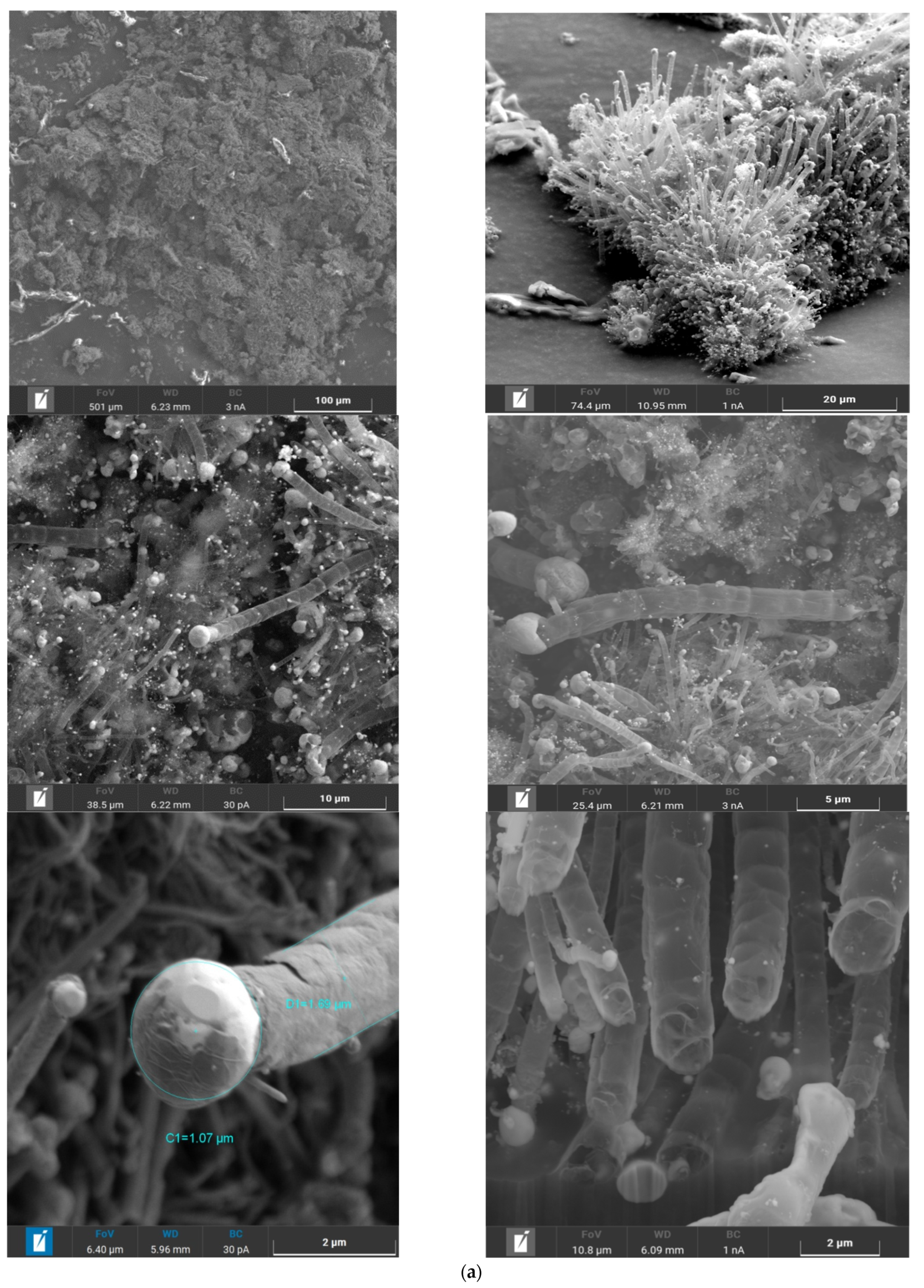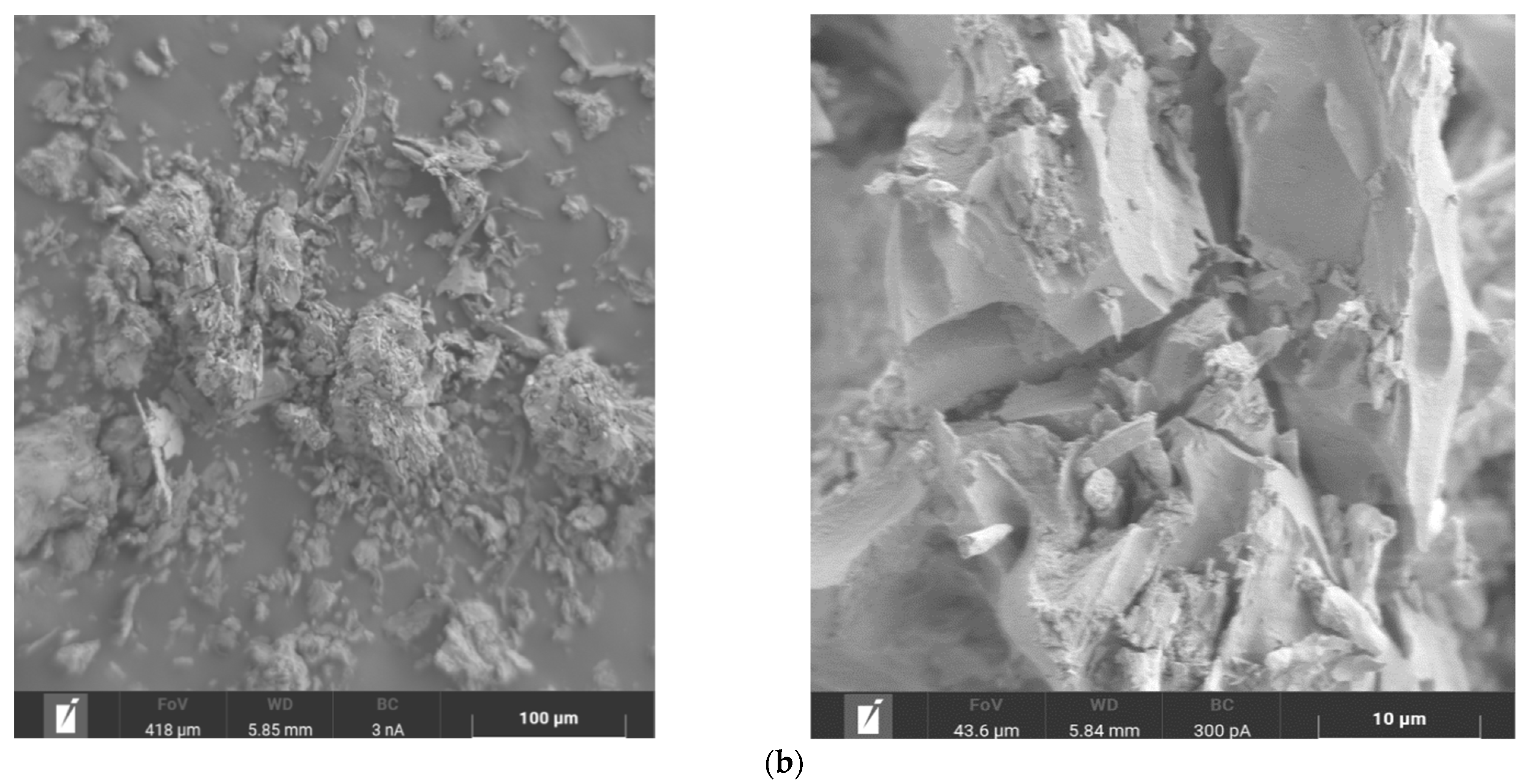Catalytic Activity of Thermolyzed [Co(NH3)6][Fe(CN)6] in CO Hydrogenation Reaction
Abstract
:1. Introduction
2. Results and Discussion
2.1. Characterization of Catalytic Compositions
2.2. Catalytic Tests
3. Materials and Methods
3.1. Materials
3.2. Obtaining Catalytic Compositions
3.3. STA Measurements
3.4. Isothermal Experiments
3.5. Physicochemical Research Methods
3.6. Sample Preparation for Micrographs
3.7. Catalytic Tests
3.8. Analysis of Reagents and Reaction Products in FTS
4. Conclusions
Supplementary Materials
Author Contributions
Funding
Institutional Review Board Statement
Informed Consent Statement
Data Availability Statement
Acknowledgments
Conflicts of Interest
Sample Availability
References
- Gholami, Z.; Tišler, Z.; Rubáš, V. Recent advances in Fischer-Tropsch synthesis using cobalt-based catalysts: A review on supports, promoters, and reactors. Catal. Rev. 2020, 1–84. [Google Scholar] [CrossRef]
- De la Peña O’Shea, V.A.; Álvarez-Galván, M.C.; Campos-Martín, J.M.; Fierro, J.L.G. Fischer–Tropsch synthesis on mono- and bimetallic Co and Fe catalysts in fixed-bed and slurry reactors. Appl. Catal. A Gen. 2007, 326, 65–73. [Google Scholar] [CrossRef]
- Ma, X.; Sun, Q.; Cao, F.; Ying, W.; Fang, D. Effects of the Different Supports on the Activity and Selectivity of Iron-Cobalt Bimetallic Catalyst for Fischer-Tropsch Synthesis. J. Nat. Gas Chem. 2006, 15, 335–339. [Google Scholar] [CrossRef]
- Akbari, M.; Mirzaei, A.A.; Atashi, H.; Arsalanfar, M. Effect of microemulsion parameters on product selectivity of MgO-supported iron–cobalt–manganese–potassium nanocatalyst for Fischer–Tropsch synthesis using response surface methodology. J. Taiwan Inst. Chem. Eng. 2018, 91, 396–404. [Google Scholar] [CrossRef]
- Griboval-Constant, A.; Butel, A.; Ordomsky, V.V.; Chernavskii, P.A.; Khodakov, A.Y. Cobalt and iron species in alumina supported bimetallic catalysts for Fischer–Tropsch reaction. Appl. Catal. A Gen. 2014, 481, 116–126. [Google Scholar] [CrossRef]
- Zakharova, E.Y.; Makhaneva, A.Y.; Kulikova, M.V.; Chudakova, M.V.; Ivantsov, M.I.; Dementyeva, O.D.; Kuznetsov, A.N. Metal-rich tellurides PdTe1−xBix as functional materials: Catalytic behavior in the Fischer–Tropsch synthesis and bonding analysis. Funct. Mater. Lett. 2020, 13, 2041001. [Google Scholar] [CrossRef]
- Kulikova, M.V.; Ivantsov, M.I.; Zemtsov, L.M.; Chernavskii, P.A.; Karpacheva, G.P.; Bondarenko, G.N.; Khadzhiev, S.N. Catalytic and magnetic properties of nanocomposites based on iron-containing polymer microspheres in Fischer-Tropsch synthesis. Pet. Chem. 2015, 55, 202–208. [Google Scholar] [CrossRef]
- Kulikova, M.V.; Ivantsov, M.I.; Efimov, M.N.; Zemtsov, L.M.; Chernavskii, P.A.; Karpacheva, G.P.; Khadzhiev, S.N. Formation features of composite materials containing cobalt nanoparticles active in Fischer-Tropsch synthesis. Eur. Chem. Bull. 2015, 4, 181–185. [Google Scholar] [CrossRef]
- Potemkin, D.I.; Filatov, E.Y.; Zadesenets, A.V.; Gorlova, A.M.; Nikitina, N.A.; Pichugina, D.A. A comparative study of CO preferential oxidation over Pt and Pt0.5Co0.5 nanoparticles: Kinetic study and quantum-chemical calculations. Mater. Lett. 2020, 260, 126915. [Google Scholar] [CrossRef]
- Potemkin, D.I.; Semitut, E.Y.; Shubin, Y.V.; Plyusnin, P.E.; Snytnikov, P.V.; Makotchenko, E.V.; Osadchii, D.Y.; Svintsitskiy, D.A.; Venyaminov, S.A.; Korenev, S.V.; et al. Silica, alumina and ceria supported Au–Cu nanoparticles prepared via the decomposition of [Au(en)2]2[Cu(C2O4)2]3·8H2O single-source precursor: Synthesis, characterization and catalytic performance in CO PROX. Catal. Today 2014, 235, 103–111. [Google Scholar] [CrossRef]
- Potemkin, D.I.; Saparbaev, E.S.; Zadesenets, A.V.; Filatov, E.Y.; Snytnikov, P.V.; Sobyanin, V.A. Preferential CO Oxidation on Bimetallic Pt0.5M0.5 Catalysts (M = Fe, Co, Ni) Prepared from Double Complex Salts. Catal. Ind. 2018, 10, 62–67. [Google Scholar] [CrossRef]
- Khassin, A.; Pechenyuk, S.I.; Domonov, D.P.; Minyukova, T.P.; Chermashentseva, G.K.; Kustova, G.N.; Plyasova, L.M. Catalytic properties OF bimetallic catalysts based on binary complexes of transition metals in fischer-tropsch synthesis. Chem. Sustain. Dev. 2007, 15, 673–683. [Google Scholar]
- Pechenyuk, S.I.; Domonov, D.P.; Gosteva, A.N. Thermal decomposition of cationic, anionic and double complex compounds of 3d-metals. Russ. Chem. J. 2018, 62, 116–140. [Google Scholar]
- Pechenyuk, S.I.; Domonov, D.P.; Shimkin, A.A.; Semushina, Y.P.; Ivanov, Y.V. Thermal behavior of binary complex compounds containing the hexacyanoferrate anion. Russ. J. Gen. Chem. 2017, 87, 2212–2223. [Google Scholar] [CrossRef]
- Pechenyuk, S.I.; Domonov, D.P.; Gosteva, A.N.; Semushina, Y.P.; Shimkin, A.A. Thermal behavior of double complexes [Co(NH3)6][Fe(CN)6] and [CO(en)3][Fe(CN)6]·2H2O. Izv. Vyss. Uchebnykh Zaved. Khimiya Khimicheskaya Tekhnologiya 2018, 61, 49. [Google Scholar] [CrossRef] [Green Version]
- Fu, T.; Jiang, Y.; Lv, J.; Li, Z. Effect of carbon support on Fischer–Tropsch synthesis activity and product distribution over Co-based catalysts. Fuel Process. Technol. 2013, 110, 141–149. [Google Scholar] [CrossRef]
- Lyu, S.; Peng, B.; Kuang, T.; Rappé, K.G.; Zhang, Y.; Li, J.; Wang, L. Supported Cobalt Nanoparticles with a Single Active Phase for Fischer–Tropsch Synthesis. ACS Appl. Nano Mater. 2019, 2, 2266–2272. [Google Scholar] [CrossRef]
- Vosoughi, V.; Badoga, S.; Dalai, A.K.; Abatzoglou, N. Effect of Pretreatment on Physicochemical Properties and Performance of Multiwalled Carbon Nanotube Supported Cobalt Catalyst for Fischer–Tropsch Synthesis. Ind. Eng. Chem. Res. 2016, 55, 6049–6059. [Google Scholar] [CrossRef]
- Kuang, T.; Lyu, S.; Liu, S.; Zhang, Y.; Li, J.; Wang, G.; Wang, L. Controlled synthesis of cobalt nanocrystals on the carbon spheres for enhancing Fischer–Tropsch synthesis performance. J. Energy Chem. 2019, 33, 67–73. [Google Scholar] [CrossRef] [Green Version]
- Lapidus, A.L.; Krylova, A.Y. On mechanism of formation of liquid hydrocarbons from CO and H2 on cobalt catalysts. Ross. Khimicheskij Zhurnal (Zhurnal Ross. Khimicheskogo Obs. Im. D.I. Mendeleeva) 2000, 44, 43–57. [Google Scholar]
- Abbaslou, R.M.M.; Soltan, J.; Dalai, A.K. Effects of nanotubes pore size on the catalytic performances of iron catalysts supported on carbon nanotubes for Fischer–Tropsch synthesis. Appl. Catal. A Gen. 2010, 379, 129–134. [Google Scholar] [CrossRef]
- Maximov, A.L.; Kulikova, M.V.; Dementyeva, O.S.; Ponomareva, A.K. Cobalt-Containing Dispersion Catalysts for Three-Phase Fischer–Tropsch Synthesis. Front. Chem. 2020, 8. [Google Scholar] [CrossRef]
- Cheng, K.; Virginie, M.; Ordomsky, V.V.; Cordier, C.; Chernavskii, P.A.; Ivantsov, M.I.; Paul, S.; Wang, Y.; Khodakov, A.Y. Pore size effects in high-temperature Fischer–Tropsch synthesis over supported iron catalysts. J. Catal. 2015, 328, 139–150. [Google Scholar] [CrossRef]
- Kulikova, M.; Chudakova, M.; Ivantsov, M.; Kuz’min, A.; Krylova, A.; Maksimov, A. Properties of Cu-Co Composite Catalysts for Synthesis of Aliphatic Alcohols. J. Braz. Chem. Soc. 2021. [Google Scholar] [CrossRef]
- Domonov, D.P.; Kuratieva, N.V.; Pechenyuk, S.I. Structure and properties of double complex salts [Co(NH3)6][Fe(CN)6] and [Co(NH3)6] 2[Cu(C2O4)2]3. J. Struct. Chem. 2011, 52, 358–364. [Google Scholar] [CrossRef]
- Pechenyuk, S.I.; Domonov, D.P.; Rogachev, D.L.; Belyavskii, A.T. Anion effect on the thermolysis of double complexes [Co(NH3)6][Fe(CN)6] and [Co(NH3)6]4[Fe(CN)6]3. Russ. J. Inorg. Chem. 2007, 52, 1033–1038. [Google Scholar] [CrossRef]
- Pechenyuk, S.I.; Semushina, Y.P.; Kadyrova, G.I.; Rogachev, D.L.; Kuz’mich, L.F.; Domonov, D.P.; Kalinnikov, V.T. Synthesis and Properties of Double Complex Salts Containing the Cation [Co(NH3)6]3+. Russ. J. Coord. Chem. 2005, 31, 866–871. [Google Scholar] [CrossRef]






| Precursor | T, °C | No. Sample | Residue from Calcination, wt.% | Co, wt.% | Fe, wt.% | Al, wt.% | Gross Formula | XRD |
|---|---|---|---|---|---|---|---|---|
| DCS | 650 | I | 41.0 | 34.4 | 33.2 | - | CoFeC3.7N0.04 | Co0.5Fe0.5 |
| DCS + Al(OH)3 | 350 | II | 35.5 | 9.8 | 9.0 | 27.4 | CoFeC0.2H0.4Al7Ox(x > 1.2) | CoFe2O4, CoO, Fe3O4 |
| Sample I, μm | Sample II, μm | |
|---|---|---|
| 5% particle | 1.37 μm | 5.99 μm |
| 25% particle | 2.40 μm | 14.69 μm |
| 75% particle | 3.89 μm | 26.99 μm |
| 100% particle | 7.00 μm | 109.88 μm |
| Vdes (d = 2–50 nm), sm3g−1 | S (d = 2–50 nm), m2g−1 | Vdes (d > 50 nm), sm3g−1 | S, (d > 50 nm), m2g−1 | SBET, m2g−1 | Vdes, sm3g−1 | Average Pore Size, nm | |
|---|---|---|---|---|---|---|---|
| Sample I | 0161 | 91.448 | 0.079 | 5.706 | 64.6 | 0.24 | 9.9 |
| Sample II | 0.200 | 230.854 | 0.014 | 1.145 | 218.5 | 0.21 | 3.7 |
| Catalyst | Parameter | Temperature, °C | ||||||
|---|---|---|---|---|---|---|---|---|
| 210 | 230 | 250 | 270 | 290 | 310 | 330 | ||
| I | KCO,% | 3 | 4 | 6 | 15 | 23 | 47 | 93 |
| SC1–C4 | 10 | 20 | 46 | 46 | 56 | 52 | 61 | |
| SC5+ | 90 | 80 | 46 | 44 | 36 | 42 | 37 | |
| SOxy | 0 | 0 | 8 | 10 | 8 | 6 | 2 | |
| A, molCO·gMe−1 c−1 | 0.9 | 1.4 | 2.1 | 4.8 | 7.6 | 15.5 | 30.6 | |
| II | KCO,% | 2 | 4 | 5 | 7 | 20 | 35 | - |
| SC1–C4 | 0 | 2 | 11 | 31 | 29 | 34 | - | |
| SC5+ | 100 | 98 | 89 | 61 | 61 | 58 | - | |
| SOxy | 0 | 0 | 0 | 8 | 10 | 8 | - | |
| A, molCO·gMe−1 c−1 | 1.3 | 2.9 | 3.3 | 4.8 | 13.5 | 23.5 | - | |
| n-Paraffins | Iso-Paraffins | Olefins | αHC | αOxy | |
|---|---|---|---|---|---|
| I | 39.9 | 36.8 | 23.3 | 0.69 | 0.28 |
| II | 66.7 | 21.4 | 11.9 | 0.81 | 0.29 |
Publisher’s Note: MDPI stays neutral with regard to jurisdictional claims in published maps and institutional affiliations. |
© 2021 by the authors. Licensee MDPI, Basel, Switzerland. This article is an open access article distributed under the terms and conditions of the Creative Commons Attribution (CC BY) license (https://creativecommons.org/licenses/by/4.0/).
Share and Cite
Gosteva, A.N.; Kulikova, M.V.; Semushina, Y.P.; Chudakova, M.V.; Tsvetov, N.S.; Semushin, V.V. Catalytic Activity of Thermolyzed [Co(NH3)6][Fe(CN)6] in CO Hydrogenation Reaction. Molecules 2021, 26, 3782. https://doi.org/10.3390/molecules26133782
Gosteva AN, Kulikova MV, Semushina YP, Chudakova MV, Tsvetov NS, Semushin VV. Catalytic Activity of Thermolyzed [Co(NH3)6][Fe(CN)6] in CO Hydrogenation Reaction. Molecules. 2021; 26(13):3782. https://doi.org/10.3390/molecules26133782
Chicago/Turabian StyleGosteva, Alevtina N., Mayya V. Kulikova, Yulya P. Semushina, Mariya V. Chudakova, Nikita S. Tsvetov, and Vasilii V. Semushin. 2021. "Catalytic Activity of Thermolyzed [Co(NH3)6][Fe(CN)6] in CO Hydrogenation Reaction" Molecules 26, no. 13: 3782. https://doi.org/10.3390/molecules26133782






